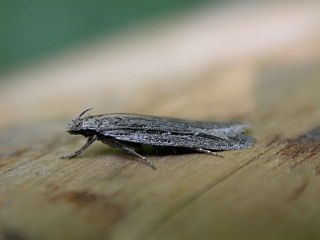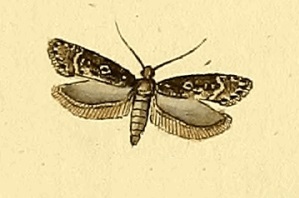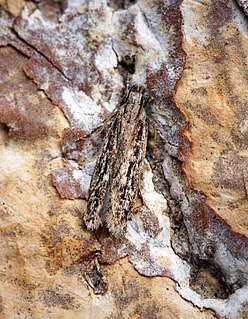Coleotechnites is a genus of moths in the family Gelechiidae described by Vactor Tousey Chambers in 1880. One of the best known species is the lodgepole needle miner, a serious pest of forest trees in North America.
Exoteleia is a genus of moth in the family Gelechiidae.
Gelechia is a genus of moth in the family Gelechiidae. The type species is Gelechia rhombella.

The Angoumois grain moth is a species of gelechioid moth. It is the type species of its genus Sitotroga, placed in the subfamily Pexicopiinae of the twirler moth family (Gelechiidae). Formerly, it was included in the "Chelariinae", which more recent authors do not separate from the Pexicopiinae and usually even do not consider a distinct tribe ("Chelariini") within them.

The juniper gelechiid moth is a moth of the family Gelechiidae. It is known from most of Europe. It is an introduced species in Great Britain and North America through accidental introduction in garden junipers.

Gelechia sororculella, the dark-striped groundling, is a moth of the family Gelechiidae. It is widely distributed from Europe, throughout Siberia to the Russian Far East.
Gelechia jakovlevi is a moth of the family Gelechiidae. It is found in Finland, the Baltic region, Ukraine, the European part of Russia, Siberia and Mongolia.
Gelechia turpella, the grand groundling, is a moth of the family Gelechiidae. It is widely distributed in Europe. Outside of Europe, it is found from the Caucasus to Siberia and the Russian Far East. The habitat consists of woodlands and parks.

Gelechia sestertiella is a moth of the family Gelechiidae. It was described by Gottlieb August Wilhelm Herrich-Schäffer in 1854. It is found in Norway, Sweden, Finland, France, Germany, Denmark, Italy, Austria, Switzerland, the Czech Republic, Slovakia, Hungary, the Baltic region, Ukraine, Belarus and Russia.

Gelechia senticetella, the cypress groundling, is a moth of the Gelechiidae family. It was described by Otto Staudinger in 1859. It is found in most of Europe, including Austria, Belgium, Bosnia and Herzegovina, Croatia, Cyprus, France, Germany, Greece, Hungary, Italy, the Republic of Macedonia, Sicily, Slovakia, Spain, Switzerland and Ukraine. It is thought to be an introduced species in Great Britain.

Gelechia scotinella, the thicket groundling, is a moth of the family Gelechiidae. It was described by Gottlieb August Wilhelm Herrich-Schäffer in 1854 and is found in almost all of Europe. The habitat consists of mature hedgerows and scrubland.

Gelechia rhombelliformis is a moth of the family Gelechiidae. It was described by Staudinger in 1871. It is found from the Netherlands and Germany east to Russia and from Denmark and Latvia south to Austria, Hungary and Romania.
Gelechia cuneatella, the long-winged groundling, is a moth of the family Gelechiidae. It was described by Douglas in 1852. It is found in northern, central and eastern Europe, Russia, China and Japan. The habitat consists of river banks and marshes.
Gelechia atlanticella is a moth of the family Gelechiidae. It is found in Morocco and Spain.
Gelechia obscurella is a moth in the family Gelechiidae. It is found in North America, where it has been recorded from Kentucky.

Gelechia asinella is a moth of the family Gelechiidae. It is found in France, Germany, Austria, Switzerland, Italy, the Czech Republic, Slovakia, Slovenia, Serbia, Hungary, Romania and Poland, as well as on Corsica.
Gelechia aspoecki is a moth of the family Gelechiidae. It is found in southern France.
Gelechia dujardini is a moth of the family Gelechiidae. It is found in France, Croatia, the Republic of Macedonia, Greece, Italy and Turkey.
Gelechia mediterranea is a moth of the family Gelechiidae. It is found in France, Spain and Greece, as well as on Sardinia and Crete.
Gelechia sirotina is a moth of the family Gelechiidae. It is found in Belarus, Tajikistan and the Russian Far East.










